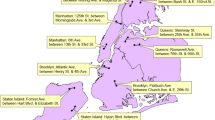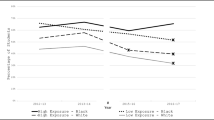Abstract
Obesity is a national public health concern linked to numerous chronic health conditions among Americans of all age groups. Evidence suggests that discretionary calories from sugary drink consumption have been a significant contributor to excess caloric intake among both children and adults. Research has established strong links between retail food environments and purchasing habits of consumers, but little information exists on the sugary drink retail environment in urban neighborhoods. The objective of this assessment was to compare various aspects of the sugary drink retail environment across New York City (NYC) neighborhoods with disparate self-reported sugary drink consumption patterns. In-store retail audits were conducted at 883 corner stores, chain pharmacies, and grocery stores in 12 zip codes throughout NYC. Results showed that among all beverage types assessed, sugary drinks had the most prominent presence in the retail environment overall, which was even more pronounced in higher-consumption neighborhoods. In higher- versus lower-consumption neighborhoods, the mean number of sugary drink varieties available at stores was higher (11.4 vs. 10.4 varieties), stores were more likely to feature sugary drink advertising (97 vs. 89 %) and advertising at multiple places throughout the store (78 vs. 57 %), and several sugary drinks, including 20-oz Coke® or Pepsi®, were less expensive ($1.38 vs. $1.60). These results, all statistically significant, indicate that neighborhoods characterized by higher levels of sugary drink consumption expose shoppers to sugary drinks to a greater extent than lower-consumption neighborhoods. This builds upon evidence documenting the association between the environment and individual behavior.


Similar content being viewed by others
References
Centers for Disease Control and Prevention. (2011). Overweight and Obesity. Atlanta, GA: Centers for Disease Control and Prevention. Available at: http://www.cdc.gov/obesity/index.html. Accessed 15 Dec 2011.
Neovius, M., Sandström, J., & Rasmussen, F. (2009). Combined effects of overweight and smoking in late adolescence on subsequent mortality: Nationwide cohort study. BMJ, 338(7695), 1–8.
Stewart, S. T., Cutler, D. M., & Rosen, A. B. (2009). Forecasting the effects of obesity and smoking on US life expectancy. New England Journal of Medicine, 361(23), 2252–2260.
Sturm, R. (2002). The effects of obesity, smoking, and drinking on medical problems and costs. Health Affairs (Millwood), 21(2), 245–253.
Sturm, R., Ringel, J. S., & Andreyeva, T. (2004). Increasing obesity rates and disability trends. Health Affairs (Millwood), 23(2), 199–205.
World Health Organisation. (2000). Obesity: Preventing and managing a global epidemic. Report of a WHO Consultation of Obesity (Technical Report Series 894). World Health Organisation, Geneva.
Bambra, C. L., Hillier, F. C., Moore, H. J., Summerbell, C. D. (2012). Tackling inequalities in obesity: A protocol for a systematic review of the effectiveness of public health interventions at reducing socioeconomic inequalities in obesity amongst children. Systematic Reviews, 1(16), 1–7.
Kirby, J. B., Liang, L. E., Chien, H. J., & Wang, Y. (2012). Race, place, and obesity: The complex relationships among community racial/ethnic composition, individual race/ethnicity, and obesity in the US. American Journal of Public Health, 102(8), 1572–1578.
Flegal, K. M., Carroll, M. D., Kit, B. K., & Ogden, C. L. (2012). Prevalence and trends in obesity among US adults 1999–2010. Journal of the American Medical Association, 307(5), 491–497.
Ogden, C. L., Carroll, M. D., Kit, B. K., & Flegal, K. M. (2012). Prevalence and trends in obesity among US adolescents and children 1999–2010. Journal of the American Medical Association, 307(5), 483–490.
Cohen, D. A., Sturm, R., Lara, M., Gilbert, M., & Gee, S. (2010). Discretionary calorie intake a priority for obesity prevention: Results of rapid participatory approaches in low-income US communities. Journal of Public Health, 32(3), 379–386.
Nielsen, S. J., Siega-Riz, A. M., & Popkin, B. M. (2002). Trends in energy intake in US between 1977 and 1996: Similar shifts seen across age groups. Obesity Research, 10(5), 370–378.
Guthrie, J. F., & Morton, J. F. (2000). Food sources of added sweeteners in the diets of Americans. Journal of the American Dietetic Association, 100(1), 43–51.
Reedy, J., & Krebs-Smith, S. M. (2010). Dietary sources of energy, solid fats, and added sugars among children and adolescents in the US. Journal of the American Dietetic Association, 110(10), 1477–1484.
Fung, T. T., Malik, V., Rexrode, K. M., Manson, J. E., Willett, W. C., & Hu, F. B. (2009). Sweetened beverage consumption and risk of coronary heart disease in women. American Journal of Clinical Nutrition, 89(4), 1037–1042.
Malik, V. S., Popkin, B. M., Bray, G. A., Despres, J. P., Willett, W. C., & Hu, F. B. (2010). Sugar-sweetened beverages and risk of metabolic syndrome and type 2 diabetes: a meta-analysis. Diabetes Care, 33(11), 2477–2483.
Welsh, J. A., Sharma, A., Cunningham, S. A., & Vos, M. B. (2011). Consumption of added sugars and indicators of cardiovascular disease risk among US adolescents. Circulation, 123(3), 249–257.
Rose, D., Hutchinson, P. L., Bodor, J. N., et al. (2009). Neighborhood food environments and body mass index: The importance of in-store contents. American Journal of Preventive Medicine, 37(3), 214–219.
Farley, T. A., Rice, J., Bodor, J. N., Cohen, D. A., Bluthenthal, R. N., & Rose, D. (2009). Measuring the food environment: shelf space of fruits, vegetables, and snack foods in stores. Journal of Urban Health, 86(5), 672–682.
Gebauer, H., & Laska, M. N. (2011). Convenience stores surrounding urban schools: An assessment of healthy food availability, advertising and product placement. Journal of Urban Health, 88(4), 616–622.
Drewnowski, A., Aggarwal, A., Hurvitz, P. M., Monsivais, P., & Moudon, A. V. (2012). Obesity and supermarket access: Proximity or price? American Journal of Public Health, 102(8), e74–e80.
Beaulac, J., Kristjansson, E., & Cummins, S. (2009). A systematic review of food deserts, 1966–2007. Preventing Chronic Disease, 6(3), 1–10.
Horowitz, C. R., Colson, K. A., Hebert, P. L., & Lancaster, K. (2004). Barriers to buying healthy foods for people with diabetes: Evidence of environmental disparities. American Journal of Public Health, 94(9), 1549–1554.
Block, D., & Kouba, J. (2006). A comparison of the availability and affordability of a market basket in two communities in the Chicago area. Public Health Nutrition, 9(7), 837–845.
Lee, H. (2012). The role of local food availability in explaining obesity risk among young school-aged children. Social Science and Medicine, 74(8), 1193–1203.
Hosler, A. S., Rajulu, D. T., Fredrick, B. L., & Ronsani, A. E. (2008). Assessing retail fruit and vegetable availability in urban and rural underserved communities. Preventing Chronic Disease, 5(4), 1–9.
Leone, A. F., Rigby, S., Betterley, C., et al. (2011). Store type and demographics influence on the availability and price of healthful foods, Leon County, Florida, 2008. Preventing Chronic Disease, 8(6), 1–8.
Hilmers, A., Hilmers, D. C., & Dave, J. (2012). Neighborhood disparities in access to healthy foods and their effects on environmental justice. American Journal of Public Health, 102(9), 1644–1654.
Bassett, M. T. (2012). Of personal choice and level playing fields: Why we need government policies on food content. American Journal of Public Health, 102(9), 1624.
New York City Department of Health and Mental Hygiene. Epiquery: NYC Interactive Health Data System—Community Health Survey 2009. Available at: http://nyc.gov/health/epiquery. Accessed 20 Jun 2012.
Marcello, R. K., Mortezazadeh, C., Chang, C., & Farley, T. (2011). Take care New York 2012: Tracking the city’s progress, 2009–2010. New York, NY: New York City Department of Health and Mental Hygiene.
New York City Department of Health and Mental Hygiene. Epiquery: NYC Interactive Health Data System—US Census 2000. Available at: http://nyc.gov/health/epiquery. Accessed 20 Jun 2012.
Gordon, C., Ghai, N., Purciel, M., Talwalkar, A., & Goodman, A. (2007). Eating well in Harlem: how available is healthy food. New York, NY: New York City Department of Health and Mental Hygiene.
Graham, R., Kaufman, L., Novoa, Z., & Karpati, A. (2006). Eating in, eating out, eating well: access to healthy food in North and Central Brooklyn. New York, NY: New York City Department of Health and Mental Hygiene.
Alberti, P., & Noyes, P. (2011). Sugary drinks: How much do we consume. New York, NY: New York City Department of Health and Mental Hygiene.
Ogden, C. L., Kit, B. K., Carroll, M. D., & Park, S. (2011). Consumption of sugar drinks in the US, 2005–2008. NCHS data brief, no 71. Hyattsville, MD: National Center for Health Statistics.
Centers for Disease Control and Prevention. (2010). National Youth Physical Activity and Nutrition Study. Available at: http://www.cdc.gov/healthyYouth/yrbs/pdf/nypans/2010nypans_questionnaire.pdf.
Inman, J. J., & Winer, R. S. (1998). Where the rubber meets the road: A model of in-store consumer decision making. Marketing Science Institute, 98–122, 1–34.
Point of Purchase Advertising International (2012). 2012 Shopper Engagement Survey. Chicago, IL: Point of Purchase Advertising International. Available at: http://www.popai.com/engage/?p=52. Accessed 25 Sep 2012.
Grier, S. A., & Kumanyika, S. K. (2008). The context for choice: Health implications of targeted food and beverage marketing to African Americans. American Journal of Public Health, 98(9), 1616–1629.
McGinnis, M., Goodman, J. A., & Kraak, V. I. (2006). Food marketing to children and youth: threat or opportunity. Washington, DC: IOM, Food and Nutrition Board.
Farley, T. A., Baker, E. T., Futrell, L., & Rice, J. C. (2010). The ubiquity of energy-dense snack foods: A national multicity study. American Journal of Public Health, 100(2), 306–311.
Acknowledgments
This project was supported in part by a cooperative agreement from CDC’s Communities Putting Prevention to Work (CPPW) program (3U58DP002418-01S1). The findings and conclusions are those of the authors and do not necessarily represent the views of the Centers for Disease Control and Prevention. Special thanks to Tamara Dumanovsky, Philip Alberti, Carolyn Olson, Christa Myers, Lynn Silver, and the NYC DOHMH CPPW Research and Evaluation Workgroup for assistance with research design and analysis. Thanks to Cathy Nonas for her review of this paper, to Lillian Dunn and Ryan Ruff for assistance with analysis, and to Pathu Sriphanlop for performing a data check. Thanks also to our data collectors: Thao Bui, Christine C. Caruso, Jason Codjoe, Kathleen Delgado, Devin Madden, Yemisi Okusanya, and Nirav Patel.
Author information
Authors and Affiliations
Corresponding author
Rights and permissions
About this article
Cite this article
Adjoian, T., Dannefer, R., Sacks, R. et al. Comparing Sugary Drinks in the Food Retail Environment in Six NYC Neighborhoods. J Community Health 39, 327–335 (2014). https://doi.org/10.1007/s10900-013-9765-y
Published:
Issue Date:
DOI: https://doi.org/10.1007/s10900-013-9765-y




